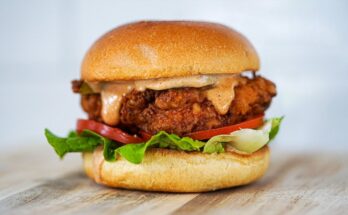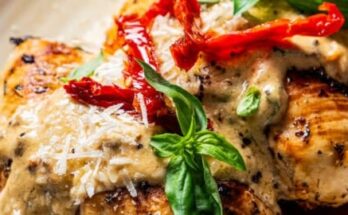Challah French Toast Recipe: Is there anything better than warm, golden, custard-soaked French toast on a lazy weekend morning? Especially when it’s made with challah—a rich, tender, slightly sweet bread that takes this classic breakfast to a whole new level. Challah French Toast isn’t just breakfast; it’s comfort on a plate. Whether you’re making it for a special occasion, a cozy brunch, or just treating yourself, this recipe will help you create the ultimate French toast experience from scratch.
This isn’t just a quick recipe drop. We’re diving deep. You’ll learn everything from choosing the right loaf to perfecting your custard soak, all the way through to serving it up with drool-worthy toppings. So grab your apron, and let’s turn your kitchen into the best brunch spot in town.
What Makes Challah Perfect for French Toast
Challah is basically the gold standard of bread when it comes to French toast. Why? It’s all about texture and flavor. Unlike regular sandwich bread, challah is soft, rich, and slightly eggy, which means it soaks up the custard without falling apart. The braided shape also gives it that wow factor on the plate.
Challah is made with eggs and sometimes a touch of honey, which gives it a slight sweetness and a pillowy crumb. This kind of bread holds up beautifully when soaked in the egg and milk mixture—it absorbs just the right amount without getting soggy. And when you grill it? It toasts up with a beautifully crisp exterior while staying creamy on the inside.
Plus, that natural richness of challah makes it feel indulgent even before you add syrup, powdered sugar, or fruit. If you’re after the ultimate French toast texture—crispy edges, soft custardy middle—challah is your best friend.
Why You’ll Love This Recipe
You’ve had French toast before, sure. But once you’ve had it made with thick slices of fresh challah, custard-soaked and perfectly golden, there’s no going back. Here’s why this will be your go-to French toast recipe:
- Rich, creamy texture: The inside turns almost like bread pudding, while the outside gets beautifully caramelized.
- Customizable flavors: Add cinnamon, vanilla, nutmeg, citrus zest—whatever suits your morning vibe.
- Perfect for brunch guests: It looks and tastes gourmet, but it’s super simple to make.
- Easy to prep ahead: You can even make it the night before and cook it in the morning.
This recipe is more than just mixing eggs and milk. It’s a step-by-step guide to elevating a breakfast staple into something worthy of your favorite brunch café.
List of Ingredients You’ll Need
Basic Ingredients
To make classic challah French toast, here’s what you need:
- Challah Bread – 1 loaf (preferably 1–2 days old)
- Eggs – 4 large
- Milk – 1 cup (whole milk or half-and-half is best)
- Heavy Cream – ½ cup (optional for extra richness)
- Vanilla Extract – 1 teaspoon
- Ground Cinnamon – 1 teaspoon
- Salt – A pinch
- Butter – For frying
- Maple Syrup – For serving
Optional Flavor Enhancers
Want to take things up a notch? Try adding:
- Nutmeg – ¼ teaspoon
- Orange or Lemon Zest – 1 teaspoon
- Brown Sugar – 1 tablespoon in the custard
- Almond Extract – ½ teaspoon (use with vanilla)
These little additions can completely change the flavor profile, giving your toast an aromatic and flavorful boost.
Kitchen Tools You’ll Need
Let’s make sure you’re fully equipped. Here’s what you’ll need to pull off the perfect French toast:
- Sharp bread knife (for slicing your challah)
- Large mixing bowl
- Whisk
- Measuring cups and spoons
- Shallow baking dish or wide bowl (for soaking bread)
- Non-stick skillet or griddle
- Spatula
- Wire rack (optional, for holding cooked toast)
That’s it—no fancy gadgets required, just a few kitchen staples and your favorite pan.
How to Choose the Best Challah for French Toast
The right bread can make or break this dish. Here’s what to look for:
- Texture: Slightly stale challah works best because it absorbs more custard without falling apart.
- Thickness: Aim for slices about ¾ to 1 inch thick. Too thin, and they’ll break; too thick, and they won’t cook through.
- Fresh vs. Day-old: Fresh challah is delicious, but day-old gives better structure.
- Braided or unbraided? Doesn’t matter too much for taste, but the braided loaf gives you that classic French toast look.
Pro tip: If you can find challah with raisins, it adds a lovely natural sweetness to each bite.
Step-by-Step Guide to Making Challah French Toast
Step 1: Slice the Challah
Start by slicing your loaf into thick, even slices—around ¾ to 1 inch thick. If your loaf is super fresh and soft, let the slices sit out for 30 minutes or lightly toast them to dry them out a bit. This helps prevent sogginess later.
Step 2: Prepare the Custard Mixture
In a large bowl, whisk together the eggs, milk, cream, vanilla, cinnamon, salt, and any extras like nutmeg or citrus zest. Make sure it’s fully blended and slightly frothy on top.
If you’re making a larger batch, just double or triple the ingredients. You can also mix this in a blender for extra smoothness.
Step 3: Soak the Bread
Pour the custard into a shallow dish. Lay the slices of challah into the mixture and let them soak for at least 30 seconds on each side. Don’t rush this step—this is where the magic happens.
Letting them soak too long can make them fall apart, but too short and they’ll taste dry inside.
Step 4: Preheat the Pan or Griddle
Heat a non-stick pan or griddle over medium heat. Add a knob of butter and let it melt until it starts to sizzle.
You want the pan hot but not smoking—test with a drop of custard; if it sizzles, you’re ready.
Step 5: Cook the French Toast
Place the soaked challah slices in the pan, but don’t overcrowd. Cook for about 3–4 minutes per side, or until golden brown and cooked through. Flip carefully with a spatula.
If your slices are thick, you may want to press them gently in the pan to ensure the center cooks.
Once done, transfer to a wire rack or plate lined with paper towels.
Step 6: Serve and Garnish
Stack your French toast high and top it with:
- A pat of butter
- Warm maple syrup
- Powdered sugar
- Fresh berries or sliced bananas
Want to go extra? Add whipped cream, a drizzle of Nutella, or caramelized apples.
Best Toppings for Challah French Toast
The beauty of challah French toast is that it’s incredibly versatile—you can dress it up or down, go classic or creative. Toppings not only elevate the flavor but also add texture, color, and that Instagram-worthy appeal.
Classic Sweet Toppings
If you love the traditional breakfast vibe, these will never let you down:
- Maple Syrup: Warm it up before pouring it over the toast for extra indulgence.
- Powdered Sugar: A light dusting creates that café-style look.
- Fresh Fruit: Think sliced bananas, strawberries, blueberries, or raspberries for freshness and color.
- Whipped Cream: Add a dollop on top for creamy contrast.
- Butter: Always a good idea—let it melt right into the toast for added richness.
- Honey or Agave: A drizzle adds sweetness with a floral note.
Savory Twist Ideas
Yes, French toast can go savory too. With challah’s slightly sweet flavor, it pairs beautifully with salty and spicy toppings.
- Bacon or Sausage: Crispy bacon alongside sweet syrup? Pure heaven.
- Fried Egg: Top your toast with a sunny-side-up egg for a brunchy twist.
- Avocado & Chili Flakes: Sounds crazy, tastes amazing.
- Goat Cheese & Caramelized Onions: Next-level flavor combo.
Whatever route you take, the key is balance. Sweet and salty, creamy and crunchy—it’s all about hitting those notes.
Tips for the Best French Toast Every Time
Let’s be honest—French toast can be a bit of a gamble if you don’t know the right tricks. Sometimes it turns out soggy, other times too dry or undercooked. But with these pro tips, you’ll nail it every time:
- Use day-old bread: Slightly stale challah absorbs the custard better than fresh.
- Don’t rush the soak: Give the bread time to soak up the custard, but not too long that it falls apart.
- Cook low and slow: Medium heat ensures the custard cooks through without burning the outside.
- Use butter + oil: Butter adds flavor, while a splash of oil prevents it from burning.
- Wipe the pan between batches: Keeps each slice golden without burnt bits.
- Keep warm in the oven: If making a big batch, place cooked slices on a baking sheet in a 200°F (90°C) oven until ready to serve.
These small techniques make a big difference between “meh” and “OMG, you made this?!”
Make-Ahead and Freezing Instructions
Want to prep ahead for a big brunch or just batch-cook for the week? You’re in luck—challah French toast is totally freezer-friendly and easy to reheat.
Make-Ahead (Overnight French Toast)
- Prepare everything up to the soaking stage.
- Arrange soaked slices in a baking dish, cover, and refrigerate overnight.
- In the morning, bring to room temp and cook as usual.
Freezing Cooked French Toast
- Let slices cool completely on a wire rack.
- Place them in a single layer on a baking sheet and freeze until solid.
- Transfer to a freezer bag or airtight container.
Reheating Instructions
- Oven: 350°F for 10–12 minutes (best texture).
- Toaster: Works well for thinner slices.
- Microwave: 30–60 seconds, though it may lose some crispness.
Perfect for meal prepping, holiday breakfasts, or last-minute cravings.
Common Mistakes to Avoid
Let’s be real, even the best home cooks can mess up French toast if they’re not careful. Here are a few common pitfalls and how to avoid them:
- Using fresh bread: It soaks unevenly and gets mushy.
- Too much dairy: Makes the custard too thick and hard to cook through.
- Undermixing the custard: Resulting in scrambled eggs clinging to your toast. Always whisk thoroughly.
- Overcrowding the pan: Lowers the heat and steams instead of sears.
- High heat: Burns the outside before the inside is done.
Want perfect French toast? Think patience, balance, and attention to detail. Treat it like you’re crafting the ultimate brunch experience.
How to Make It Dairy-Free or Vegan
You don’t need eggs or milk to enjoy amazing French toast. Here’s how to make it work for everyone:
Dairy-Free Version:
- Milk: Use almond milk, oat milk, or coconut milk.
- Butter: Substitute with vegan butter or coconut oil.
- Cream: Skip or use dairy-free half-and-half.
Vegan Version:
- Egg Substitute: Use mashed banana, flax eggs (1 tbsp flaxseed + 3 tbsp water), or store-bought egg replacers.
- Custard Flavor Boosters: Add cinnamon, vanilla, and a bit of maple syrup to boost flavor.
Vegan challah does exist—check your local bakery or make your own using oil instead of eggs.
Serving Suggestions for Brunch or Breakfast
If you’re going all-out for brunch, you need more than just toast on the plate. Here are some dreamy pairings:
- Mimosas or Coffee Lattes – Because brunch is a vibe.
- Fresh Fruit Platter – Adds color, texture, and a healthy balance.
- Bacon or Sausage Links – Sweet and salty magic.
- Scrambled Eggs – For a hearty, protein-packed plate.
- Greek Yogurt & Honey – Light and creamy complement.
Set the table, add a fresh flower or two, and suddenly your kitchen looks like a boutique brunch café.
Pairing Ideas – What to Serve With Challah French Toast
Whether it’s a lazy Saturday or a big holiday morning, here’s how to build a complete brunch menu around this dish:
| Dish Type | Suggestions |
|---|---|
| Protein | Scrambled eggs, sausage, bacon |
| Fruit | Berries, melon, citrus salad |
| Drinks | Coffee, tea, orange juice, mimosas |
| Sides | Roasted potatoes, hash browns |
| Extras | Whipped cream, fruit compote |
Make it a spread and let everyone customize their own plate. Bonus points if you make a toppings bar!
Storage and Reheating Tips
Leftovers? No problem. Challah French toast stores like a champ.
- Fridge: Store in an airtight container for up to 3 days.
- Freezer: Freeze between sheets of wax paper for up to 2 months.
To reheat:
- Oven: Bake at 350°F for 10 minutes.
- Skillet: Reheat on low heat with a touch of butter.
- Toaster: Great for getting the edges crispy again.
Just avoid the microwave if you want to keep that perfect texture.
Nutrition Breakdown (Per Serving)
Here’s an approximate breakdown for 2 slices, without toppings:
| Nutrient | Amount |
|---|---|
| Calories | 320–400 |
| Protein | 10–12g |
| Carbohydrates | 35–40g |
| Fat | 15–20g |
| Sugar | 5–8g |
| Fiber | 1–2g |
| Sodium | 300–400mg |
This can vary depending on your toppings and whether you use whole milk, cream, or dairy-free options.
FAQs about Challah French Toast Recipe
1. Can I use brioche instead of challah?
Absolutely! Brioche is another rich, eggy bread that works beautifully for French toast. The texture is slightly softer, but the results are equally delicious.
2. How long should I soak the bread?
Ideally, 30 seconds to 1 minute per side. You want it saturated but not falling apart.
3. Can I make this in the oven instead of a pan?
Yes, you can bake challah French toast in a 375°F oven for 20–25 minutes. Arrange the slices on a greased sheet pan and flip halfway through.
4. Why is my French toast soggy in the middle?
You may have used too much dairy or cooked on high heat. Try adjusting the custard ratio and cooking over medium heat until cooked through.
5. Can I make French toast with frozen challah?
Yes, but thaw it first and let it dry out a bit before soaking. This will help it absorb the custard better.
Conclusion
Challah French toast is one of those recipes that feels like a warm hug on a plate. It’s indulgent, comforting, and surprisingly simple to make. With a few pantry staples and a loaf of rich, tender challah, you’ve got everything you need to turn a basic breakfast into something unforgettable.
Whether you’re making it for a holiday brunch, treating your partner to breakfast in bed, or just enjoying a quiet morning solo with coffee, this dish delivers every single time. Plus, it’s totally customizable—from the custard to the toppings to the sides. So don’t be afraid to make it your own.
Give this recipe a go, and next time someone asks what you’re making for brunch, you’ll smile and say, “Only the best.”



